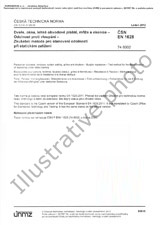We need your consent to use the individual data so that you can see information about your interests, among other things. Click "OK" to give your consent.
ČSN ETSI EN 300338-1-V1.4.1 (875031)
Technical characteristics and methods of measurement for equipment for generation, transmission and reception of Digital Selective Calling (DSC) in the maritime MF, MF/HF and/or VHF mobile service; Part 1: Common requirements
Translate name
STANDARD published on 1.9.2017
The information about the standard:
Designation standards: ČSN ETSI EN 300338-1-V1.4.1
Classification mark: 875031
Catalog number: 502436
Publication date standards: 1.9.2017
SKU: NS-693261
The number of pages: 44
Approximate weight : 132 g (0.29 lbs)
Country: Czech technical standard
Category: Technical standards ČSN
The category - similar standards:
Receiving and transmitting equipmentNavigation and control equipment
Annotation of standard text ČSN ETSI EN 300338-1-V1.4.1 (875031):
V1.4.1
The present document states the minimum requirements for equipment to be used for generation, transmission and reception of Digital Selective Calling (DSC) for use on board ships.
DSC is intended to be used in the Medium Frequency (MF), High Frequency (HF) and Very High Frequency (VHF) bands of the Maritime Mobile Service (MMS), for distress, urgency and safety communication and general communications.
The present document is a multipart deliverable that covers the requirements to be fulfilled by:
- - DSC equipment integrated with a transmitter and/or a receiver;
- - DSC equipment not integrated with a transmitter and/or a receiver.
These requirements include the relevant provisions of the ITU Radio Regulations [i.17] and Recommendations ITU R, the International Convention for the Safety Of Life At Sea (SOLAS) [i.16], and the relevant resolutions of the International Maritime Organization (IMO).
Equipment for generation, transmission and reception of DSC designed according to the following equipment classes:
- "Class A: includes all the facilities defined in annex 1 of Recommendation ITU R M.493 14 [2] and complies with the IMO Global Maritime Distress and Safety System (GMDSS) carriage requirements for MF/HF installations and/or VHF installations.
"Class B: provides minimum facilities for equipment on ships not required to use class A equipment and complies with the minimum IMO GMDSS carriage requirements for MF and/or VHF installations. This equipment should provide for:
- - alerting, acknowledgement and relay facilities for distress purposes;
- - calling and acknowledgement for general communication purposes; and
- - calling in connection with semi automatic/automatic services, as defined in Recommendation ITU R M.493 14 [2], annex 2, clause 3.
- "Class D: provides minimum facilities for VHF DSC distress, urgency and safety as well as routine calling and reception as recommended by IMO MSC/Circ.803 [i.2] for non-SOLAS vessels participating in the GMDSS.
- "Class E: provides minimum facilities for MF and/or HF DSC distress, urgency and safety as well as routine calling and reception as recommended by IMO MSC/Circ.803 [i.2] for non-SOLAS vessels participating in the GMDSS.
- "Class H: provides minimum facilities for handheld VHF DSC distress, urgency and safety as well as routine calling and reception as recommended by IMO MSC/Circ.803 [i.2] for non-SOLAS vessels participating in the GMDSS.
- "Class M: provides minimum facilities for VHF Man Overboard devices as defined in Recommendation ITU R M.493 14 [2].
NOTE 1: Class A and Class B equipment may support the optional semi-automatic/automatic service in accordance with Recommendations ITU R M.689 3 [4], M.1082-1 [5] and M.493-14 [2], tables 4.10.1 and 4.10.2 and are encouraged to do so.
NOTE 2: Class D and Class E equipment may also support the optional semi-automatic/automatic service
Preview of the standard ČSN ETSI EN 300338-1-V1.4.1 (875031)
We recommend:
Technical standards updating
Do you want to make sure you use only the valid technical standards?
We can offer you a solution which will provide you a monthly overview concerning the updating of standards which you use.
Would you like to know more? Look at this page.




 Cookies
Cookies
